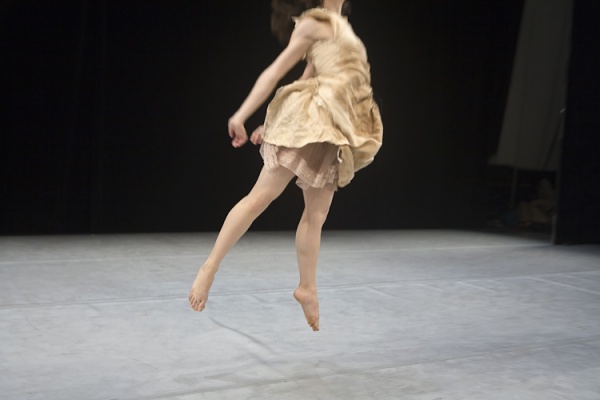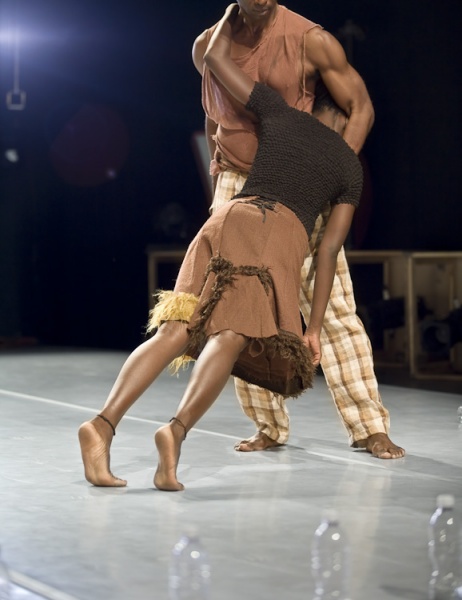To Appreciate or to Feel? That is the Question
Lightsey Darst elegantly deconstructs her experience of "The Good Dance," as envisioned by Brooklyn's Reggie Wilson and Senegal's Andreya Ouamba; in the process, she offers trenchant insights about the varied ways art may work on the viewer.




LET’S JUST ADMIT THIS: it’s not always easy to “experience” art. I put “experience” in quotation marks, because that’s the dream, right? You go on the journey the artist has provided, somehow, miraculously, at once leaving yourself behind (so you can get beyond yourself) and taking yourself along (so you can be changed). This is a tricky recipe to get right. I’m not saying it doesn’t happen — my life is more or less predicated on the idea that it does — but art experience can be as elusive as a truly felt prayer. As I recall from my praying days, once in a while you feel connected to The Big Out There; the rest of the time, the ceiling gets in the way. Or, if not the ceiling — the low-flying clouds, the ozone layer, Sputnik, a leaky roof, your own itchy gray matter, your unwashed hair — anything.
Enter The Good Dance: Dakar/Brooklyn, a Walker commissioned collaboration between Brooklyn’s Reggie Wilson and Senegal’s Andréya Ouamba. The Good Dance is spare in its unconnected, non-narrative scenes, its simple harsh light (designers Jonathan Belcher and Carrie Woods, at times, uncomfortably illuminate the audience), its unsentimental relations between bodies, and its variegated movement — bits of African, bits of contemporary modern, and a lot of gesturing, walking, kicking, and other “pedestrian” but dramatic motion — that never settles into one dance. At the same time, it’s rich in physical detail, in deconstructed semi-historical costume (by Naoko Nagata), in activity (two, three things going on at once), and in the varied shapes of the dancers — from barely there to plump to ripped, child-small to statue-tall. It’s a work of ambitious agglomeration with a severe intelligence. Wilson and Ouamba tried hard, the dancers tried hard, and I, too, tried hard — but I just wasn’t feeling it. I appreciated the heck out of it, but feeling is different.
I could blame a lot of things: the exceptionally large and clueless crowd at the Walker that night, getting hung up on every possible roadblock; the slightly overlong performance (an hour and a half, no intermission); Wilson and Ouamba’s minimal or clumsy connections between scenes; too much going on at once on stage; or my busy tomorrow that I was fretting over. But more than all that, I blame the weight of theory. It’s one thing to have program notes that set out a few ideas, but quite another to have Reggie Wilson on stage, in costume, a few minutes into the performance, saying that The Good Dance is partly about finding a good dance equivalent to the Western tradition’s good books, as he walks around balancing a water bottle on his head.
With this set-up, the dutiful viewer is bound to interrogate every moment. Wait, was that snatch of African dance the good dance? Or, was it an outmoded dance unsuited to the exigencies of this moment — which appeals to me because I’m mired in nostalgia? Is that dancer white? Is that a bad question to ask? Am I supposed to ignore that she’s white, or is she white in the piece too? If she’s white, can she have a good dance? The aggressive partnering between this small, apparently white dancer and a much larger African or African-American male dancer, already fraught with about a thousand questions, simply implodes under the weight of Wilson’s pointed talk. Or does it explode? I wanted it to, and there were moments, definitely. I loved so much of the movement, from the African-derived slack-and-catch rhythms to the space-grabbing jumps to the nearly wrestling yet choreographed-to-the-little-finger-bone partnering. Just let me watch this new organization of the body for a bit! I wanted to say. But Wilson’s talk wouldn’t let me.
______________________________________________________
When you run into a problem in art viewing, it’s good practice to consider whether the problem might be purposeful. Perhaps Wilson and Ouamba want to keep me in a state of frustration; perhaps they’re envisioning a creative tension, out of which rises… something.
______________________________________________________
Still, when you run into a problem in art viewing, it’s good practice to consider whether the problem might be purposeful. So, perhaps Wilson and Ouamba want to keep me in a state of frustration; perhaps they’re envisioning a creative tension, out of which rises… something. Or, (and I like this idea better) perhaps the “good dance” doesn’t appear until you become the good viewer. And the good viewer is clearly not the dutiful viewer, looking for what she was told she’d find, policing herself so earnestly she can’t even feel her own reaction. The good viewer is a rebel, taking what she can.
In that, she’s like the dancers. Manipulation runs through The Good Dance: dancers spin each other around, rearrange each other’s limbs, smack down each other’s gestures. But the manipulated resist — defiantly or silently, in little ways or big ones. That’s the image Wilson and Ouamba leave us with: a prone dancer, entirely inert, but for a leg that just won’t stay where his partner wants to put it.
______________________________________________________
Below is a slick video about The Good Dance, created by the Brooklyn Academy of Music.
______________________________________________________
Noted performance:
The Good Dance: Dakar/Brooklyn by Reggie Wilson/Andréya Ouamba was presented by the Walker Art Center, November 12-14.
About the writer: Lightsey Darst writes on dance for Mpls/St Paul magazine. She is also a poet who served as the founding coordinator of mnartists.org’s What Light: This Week’s Poem publication project, and the founder and host of a monthly writers’ salon, The Works, at the Bryant Lake Bowl.